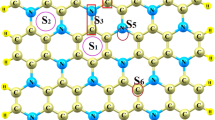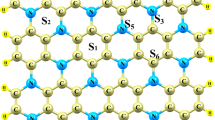Abstract
First-principles calculations based on density functional theory were used to investigate the electrochemical performance of monolayer γ-PC for Na- and K-ion batteries. Molecular dynamics simulations indicate that the monolayer γ-PC have the thermal and dynamic stability. A substantial charge transfer from the Na/K atoms to the γ-PC sheet enhances the electrical conductivity of γ-PC. The results show that the adsorption energies of Na and K are 1.53 eV and 2.04 eV, respectively, which are much higher than Na/K bulk cohesive energy and sufficiently ensure stability and safety. Additionally, the low diffusion barriers on γ-PC monolayer are 0.034 eV for Na and 0.027 eV for K, indicating excellent rate performance. The γ-PC sheet has a high theoretical capacity for both Na (519.9 mAh/g) and K (326.6 mAh/g) ion batteries, which can satisfy the requirement of energy storage devices to anode materials. Our results strongly suggest that 2D γ-PC monolayer is an exceedingly promising anode material for both NIBs and KIBs with high adsorption energies, high capacity, and low diffusion barriers.








Similar content being viewed by others
Data availability
Data generated or used during the study is available from the corresponding author by request.
Code availability
N/A.
References
Sehrawat P, Julien C, Islam SS (2016) Carbon nanotubes in Li-ion batteries: a review. Mater Sci Eng B
Obrovac MN, Chevrier VL (2014) Alloy negative Eelectrodes for Li-ion batteries. Chem Rev 114:11444–11502
Liang Y, Chen Z, Jing Y, Rong Y, Yao Y (2015) Heavily N-dopable II-conjugated redox polymers with ultrafast energy storage capability. J Am Chem Soc 137
Haxel GB, Hedrick JB, Orris GJ, Stauffer PH, Ii JWH (2002) Rare earth elements: critical resources for high technology
Yang S, Li S, Tang S, Shen D, Dong W, Sun W (2017) Adsorption, intercalation and diffusion of Na on defective bilayer graphene: a computational study. Surf Sci 658:31–37
Yabuuchi N, Kubota K, Dahbi M, Komaba S (2014) Research development on sodium-ion batteries. Chem Rev 114:11636–11682
Wu X, Leonard DP, Ji X (2017) Emerging non-aqueous potassium-ion batteries: challenges and opportunities. Chem Mater
Zhang X, Zhang Z, Yao S, Chen A, Zhou Z (2018) An effective method to screen sodium-based layered materials for sodium ion batteries. Npj Comput Math 4
Zhang W, Mao J, Li S, Chen Z, Gu Z (2017) Phosphorus-based alloy materials for advanced potassium-ion battery anode. J Am Chem Soc
Junping H, Bo X et al (2015) 2D Electrides as promising anode materials for Na-ion batteries from first-principles study. Acs Appl Mater Interfaces
Persson K, Sethuraman VA, Hardwick LJ et al (2010) Lithium diffusion in graphitic carbon[J]. J Phys Chem Lett 1(8):1176–1180
Winter M, Besenhard JO, Spahr ME et al (1998) Insertion electrode materials for rechargeable lithium batteries[J]. Adv Mater 10(10):725–763
Komaba S, Hasegawa T, Dahbi M, Kubota K (2015) Potassium intercalation into graphite to realize high-voltage/high-power potassium-ion batteries and potassium-ion capacitors. Electrochem Commun 60:172–175
Shi L, Zhao T, Xu A, Xu J (2016) Ab initio prediction of a silicene and graphene heterostructure as an anode material for Li- and Na-ion batteries. J Mater Chem 4:16377–16382
Pramudita JC, Sehrawat D, Goonetilleke D, Sharma N (2017) An initial review of the status of electrode materials for potassium‐ion batteries. Adv Energy Mater 7: 1602911.1–1602911.21
Novoselov KS, Geim AK, Morozov SV, Jiang D, Zhang Y, Dubonos SV, Grigorieva IV, Firsov AA (2004) Electric field effect in atomically thin carbon films. Science 306:666–669
Li W, Yang Y, Zhang G, Zhang YW (2015) Ultrafast and directional diffusion of lithium in phosphorene for high-performance lithium-ion battery. Nano Lett 15:1691
Geng B, Jeon KJ, Lucas IT, Richardson TJ, Wang F, Kostecki R, Pollak E (2010) The interaction of Li+ with single-layer and few-layer graphene. Nano Lett 10:3386–3388
Zhang Y, Rui X, Tang Y, Liu Y, Wei J, Chen S, Leow WR, Li W, Liu Y, Deng J (2016) Wet-chemical processing of phosphorus composite nanosheets for high-rate and high-capacity lithium-ion batteries. Adv Energy Mater 6:1502409
Jiang H, Lu Z, Wu M, Ciucci F, Zhao T (2016) Borophene: a promising anode material offering high specific capacity and high rate capability for lithium-ion batteries. Nano Energy 23:97–104
Chhowalla M, Shin HS, Eda G, Li L, Loh KP, Zhang H (2013) The chemistry of two-dimensional layered transition metal dichalcogenide nanosheets. Nat Chem 5:263–275
Tang Q, Zhou Z, Shen P (2012) Are mxenes promising anode materials for Li ion batteries? Computational studies on electronic properties and Li storage capability of Ti3c2 and Ti3c2x2 (X = F, Oh) Monolayer. J Am Chem Soc 134:16909–16916
Er D, Li J, Naguib M, Gogotsi Y, Shenoy VB (2014) Ti3c2 Mxene as a high capacity electrode material for metal (Li, Na, K, Ca) ion batteries. ACS Appl Mater Interfaces 6:11173–11179
He P, Yu H, Li D, Zhou H (2012) Layered lithium transition metal oxide cathodes towards high energy lithium-ion batteries. J Mater Chem 22:3680–3695
Zhao S, Kang W, Xue J (2014) The potential application of phosphorene as an anode material in Li-ion batteries. J Mater Chem 2:19046–19052
Sun J, Lee H, Pasta M, Yuan H, Zheng G, Sun Y, Li Y, Cui Y (2015) A Phosphorene–graphene hybrid material as a high-capacity anode for sodium-ion batteries. Nat Nanotechnol 10:980–985
Sun J, Zheng G, Lee H, Liu N, Wang H, Yao H, Yang W, Cui Y (2014) Formation of stable phosphorus–carbon bond for enhanced performance in black phosphorus nanoparticle–graphite composite battery anodes. Nano Lett 14:4573–4580
Xu J, Jeon I, Ma J, Dou Y, Kim S, Seo J, Liu H, Dou SX, Baek J, Dai L (2017) Understanding of the capacity contribution of carbon in phosphorus-carbon composites for high-performance anodes in lithium ion batteries. Nano Res 10:1268–1281
Ruan B, Wang J, Shi D, Xu Y, Chou S, Liu H, Wang J (2015) A phosphorus/N-doped carbon nanofiber composite as an anode material for sodium-ion batteries. J Mater Chem 3:19011–19017
Li W, Li H, Lu Z, Gan L, Ke L, Zhai T, Zhou H (2015) Layered phosphorus-like Gep5: a promising anode candidate with high initial coulombic efficiency and large capacity for lithium ion batteries. Energy Environ Sci 8:3629–3636
Teter DM, Hemley RJ (1996) Low compressibility carbon nitrides. Science 271:53–55
Claeyssens F, Hart JN, Allan NL, Oliva JM (2009) Solid phases of phosphorus carbide: an ab initio study. Phys Rev B 79:134115
Kuo MT, May PW, Gunn A, Ashfold MNR, Wild RK (2000) Studies of phosphorus doped diamond-like carbon films. Diamond Relat Mater 9:1222–1227
Pearce SRJ, May PW, Wild RK, Hallam KR, Heard PJ (2002) Deposition and properties of amorphous carbon phosphide films. Diamond Relat Mater 11:1041–1046
Li F, Liu X, Wang J, Zhang X, Yang B, Qu Y, Zhao M (2017) A promising alkali-metal ion battery anode material: 2d metallic phosphorus carbide ( Β 0 -Pc). Electrochim Acta :S0013468617324635
Zhang W, Yin J, Zhang P, Tang X, Ding Y (2018) Two-dimensional phosphorus carbide as a promising anode material for lithium-ion batteries. J Mater Chem 6:12029–12037
Delley B (1990) An all-electron numerical method for solving the local density functional for polyatomic molecules. J Chem Phys 92:508–517
Zhang R, Liu X, Wen Z, Jiang Q (2011) Prediction of silicon nanowires as photocatalysts for water splitting: band structures calculated using density functional theory. J Phys Chem C 115:3425–3428
Perdew JP, Burke K, Ernzerhof M (1996) Generalized gradient approximation made simple. Phys Rev Lett 77:3865–3868
Grimme S (2006) Semiempirical Gga-type density functional constructed with a long-range dispersion correction. J Comput Chem 27:1787–1799
Monkhorst HJ, Pack JD (1976) Special points for brillouin-zone integrations. Phys Rev B 13:5188–5192
Zhou Y, Zhao M, Chen ZW, Shi XM, Jiang Q (2018) Potential Application of 2d monolayer Β-Gese as an anode material in Na/K ion batteries. PCCP 20:30290–30296
Martyna GJ, Klein ML, Tuckerman M (1992) Nose?–Hoover chains: the canonical ensemble via continuous dynamics. J Chem Phys 97:2635
Verlet L (1967) Computer “experiments” on classical fluids. I. Thermodynamical properties of Lennard-Jones molecules[J]. Phys Rev 159(1):98–107
Verlet L (1967) Computer “experiments” on classical fluids. I. Thermodynamical properties of Lennard-Jones molecules[J]. Phys Rev 165:201–214
Tuckerman ME, Liu Y, Ciccotti G, Martyna GJ (2001) Non-Hamiltonian molecular dynamics: generalizing Hamiltonian phase space principles to non-Hamiltonian systems. J Chem Phys 115:1678–1702
Claeyssens F, Hart JN, Allan NL et al (2009) Solid phases of phosphorus carbide: an ab initio study[J]. Phys Rev B 79(13):897–899
Bhauriyal P, Mahata A, Pathak B (2018) Graphene-like carbon–nitride monolayer: a potential anode material for Na-and K-ion batteries[J]. J Phys Chem C 122(5):2481–2489
Zhang Z, Liu X, Yakobson BI et al (2012) Two-dimensional tetragonal TiC monolayer sheet and nanoribbons[J]. J Am Chem Soc 134(47):19326–19329
Pacchioni G, Beckmann H-O, Koutecký J (1982) Investigation of alkali-metal clusters with pseudopotential multireference double-excitation configuration interaction method. Chem Phys Lett 87(2):151–158
Ray AK, Altekar SD (1990) Ab initio many-body perturbation-theoretic study of small potassium clusters. Phys Rev B 42:1444
Noguchi Y, Ishii S, Ohno K, Sasaki T (2008) Quasiparticle energy spectra of alkali-metal clusters: all-electron first-principles calculations. J Chem Phys 129:104104
Lu T, Chen F (2012) Multiwfn: A multifunctional wavefunction analyzer[J]. J Comput Chem 33(5):580–592
Chen Q, Wang H, Li H, Duan Q, Jiang D, Hou J (2020) Two-dimensional Mnc as a potential anode material for Na/K-ion batteries: a theoretical study. J Mol Model 26:1–6
Wang D, Liu Y, Xing M, Wei Y, Gang C (2017) Two-dimensional Vs 2 monolayers as potential anode materials for lithium-ion batteries and beyond: first-principles calculations. J Mater Chem A :5
Samad A, Shafique A, Shin YH (2017) Adsorption and diffusion of mono, di, and trivalent ions on two-dimensional Tis2. Nanotechnology
Shewmon PG (2016) Diffusion in solids, 2nd edn. Springer International Publishers, Switzerland, pp 71–79
Hultsch Roland Arthur, Barnes RG (1962) Pressure dependence of self-diffusion in lithium and sodium. Phys Rev 125(6):1832
Makaremi M, Mortazavi B, Singh CV (2018) 2D Hydrogenated graphene-like borophene as a high capacity anode material for improved Li/Na ion batteries: a first principles study[J]. Materials Today Energy 8:22–28
Mansouri Z, Sibari A, Al-Shami A et al (2022) Graphene/phosphorene nano-heterostructure as a potential anode material for (K/Na)-ion batteries: Insights from DFT and AIMD[J]. Comput Mater Sci 202:110936
Jiang H, Zhao T, Ren Y, Zhang R, Wu M (2017) Ab initio prediction and characterization of phosphorene-like Sis and Sise as anode materials for sodium-ion batteries. Science Bulletin 62:572–578
Wang H, Chen Q, Li H, Duan Q, Jiang D, Hou J (2019) Two-dimensional Janus Mosse as a potential anode material for Na/K-ion batteries: a theoretical study. Chem Phys Lett 735:136777
Funding
This work was financially supported by the Department of Science and Technology of Jilin Province (grant number 20190303069SF).
Author information
Authors and Affiliations
Contributions
Bingxin Mao: investigation, data curation, writing—original draft. Hui Li: writing—reviewing and editing. Qian Duan: writing—reviewing and editing, funding acquisition. Jianhua Hou: software, writing—reviewing and editing, project administration, formal analysis.
Corresponding authors
Ethics declarations
Conflict of interest
The authors declare no competing interests.
Additional information
Publisher's note
Springer Nature remains neutral with regard to jurisdictional claims in published maps and institutional affiliations.
Supplementary Information
Below is the link to the electronic supplementary material.
Rights and permissions
About this article
Cite this article
Mao, B., Li, H., Duan, Q. et al. 2D phosphorus carbide as promising anode materials for Na/K-ion batteries from first-principles study. J Mol Model 28, 152 (2022). https://doi.org/10.1007/s00894-022-05144-5
Received:
Accepted:
Published:
DOI: https://doi.org/10.1007/s00894-022-05144-5




